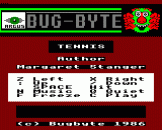Introduction
"It's 3D Arcade Centre Court action with speech against five of the world's best! Can you out volley, out serve and outwit the likes of Powerful Pierre & Norm Everidge. Ace programming by Margaret 'Champion' Stanger."
The computer displays the tennis courts, players and scoreboard and asks for the player's name to be typed in. This name appears on the scoreboard versus Manual Fawlty of Barcelona, his first opponent.
The player is asked whether he wants a one or three set match, and then for a choice between three or six games in a set. He is then asked to choose between joystick and keyboard control and the starts with Manual serving.
If the player loses the match he is invited to play against Manual again. If he wins through to the next round, he may have a chance to play against Powerful Pierre from France, Ivan the Vulgar Boatman from Russia, Norm Everidge from Australia or even the quietly spoken American, John O'Neill.
The Rules Of The Game
The game is played on a court on the screen. The computer-controlled player is at the top of the screen and the player controlled by the keys or joystick at the bottom of the screen.
The object is to hit the ball in such a way that it cannot be returned or it bounces twice in the opponent's half of the court. The opponents continue hitting the ball to and fro until one or the other places a shot that cannot be returned successfully; this wins him a point.
Each point starts with a service. The server stands with both feet behind the baseline anywhere between the centre mark and the sideline of the court, the server changing sides after each point.
The ball is served to bounce in the opponent's service court diagonally opposite him. If the first attempt is faulty, a second attempt is allowed.
The receiver must allow the ball to bounce, all subsequent shots in the rally may be volleyed (struck before it bounces) or hit as ground-strokes after the bounce.
One player continues serving until the game is compete. The opponent serves one game, and then service reverts to the next player.
The first player to win all four points wins the game, unless the score reaches three points all. When this occurs, the game continues until one of the players establishes a lead of two points.
Tennis scoring traditionally uses the scores 15, 30, and 40 rather than one, two and three. If both opponents win three points this is called 'deuce'. The next point is called advantage server or advantage receiver according to who wins it. If the same player wins the next point, he wins the game. If he loses the score reverts to deuce and the game continues until a player has a two point lead.
Tennis matches are usually won by the first player to win two sets. A set is won by the first player to win six games in the set unless the score is 6-5 or 5-6. A final deciding game or tie breaker is played when the score reaches 6-6. This game, and the set, goes to the first player with five or more points and a two point lead. The service changes after the first point, and then after every further point.
Game Controls
Z - Left, X - Right, : - Up, / - Down
SPACE BAR to hit the ball, Q - Music on, N - Music off
F/C - Freeze/Continue







